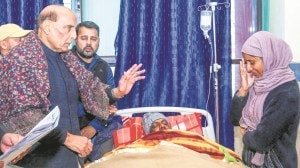- India
- International
India TB report: Decoding the key takeaways and why diabetes is a major risk factor
There were an estimated 27.8 lakh TB cases in 2023, a marginal decline from the estimated 28 lakh in 2015.
 While the number of cases and deaths due to tuberculosis has been on the decline since the baseline year of 2015, it hasn’t kept pace with the target that India has set. (Express file photo)
While the number of cases and deaths due to tuberculosis has been on the decline since the baseline year of 2015, it hasn’t kept pace with the target that India has set. (Express file photo)While India has set the goal of eliminating tuberculosis by 2025, five years ahead of the global target, the recently released government report has been a dampener — the number of cases and deaths recorded in 2023 was nowhere close to the targets that the country had set for itself. But all is not bleak. The Ni-kshay portal, which has been tracking cases, offering quick and accurate tests, has resulted in fewer “missing cases.”
Here are key takeaways from the India TB Report 2024 recently released by the Union Health Ministry.
TB and risk factors
The report flags risk factors like undernourishment, HIV, diabetes, alcohol use and smoking that affect both the infection rate and treatment outcomes.
Undernourishment: Nearly 7.44 lakh TB patients were undernourished in 2022. To improve nutrition, the government provides a monthly support of Rs 500 and has disbursed nearly Rs 2,781 crore to nearly one crore beneficiaries. Other than that, the Ni-kshay Mitra programme calls for donation of food baskets.
HIV: People living with HIV have a 20-times higher risk of developing symptoms of TB as compared to the normal population. Altogether 94,000 TB patients in 2022 had HIV. The programme provides preventive therapy to the HIV positive, ensures early diagnosis of HIV and TB through either programme.
Diabetes: Of the 3.70 lakh TB patients with diabetes globally in 2022, 1.02 lakh were in India as per estimates. Diabetes escalates the likelihood of contracting TB two-to-three fold, which in turn is linked to increased risk of multi-drug resistant TB. The TB treatment also does not work as well in diabetics. Nearly 92 per cent of the TB patients were screened for diabetes in 2023, with 7.7 per cent being diagnosed with it. And, nearly 63 per cent of those diagnosed initiating diabetes treatment as per the report.

Alcohol: A daily intake of more than 50 ml of alcohol increases the risk of TB infection, active infection and recurrence of infection. Around 18.8 lakh or 74 per cent of TB patients underwent alcohol use screening, out of which 7.1 per cent were identified as alcohol users.
Tobacco: In 2023, around 19.1 lakh or 75 per cent of TB patients were screened for tobacco use, of whom 11 per cent were identified as tobacco users. And 32 per cent of these people were linked to the tobacco cessation services as per the report.
Why we need to keep a watch on numbers
While the number of cases and deaths due to tuberculosis has been on the decline since the baseline year of 2015, it hasn’t kept pace with the target that India has set. There were an estimated 27.8 lakh TB cases in 2023, a marginal decline from the estimated 28 lakh in 2015. This translates to 199 cases per lakh population in 2023 as compared to 237 cases in 2015. The target of the national programme, however, was 77. Deaths due to the infection reduced to 23 per lakh population in 2023 as compared to 32 per lakh in 2015. The target for 2023, however, was six. The global pandemic took a toll on the programme, especially in its first year.
The positive development has been the improvement in the actual number of cases diagnosed. With a record high of 25.5 lakh cases testing positive in 2023, the gap between the estimates and actual numbers is closing. This is an important marker as the “missing cases” are assumed to have not received treatment, continuing to spread the infection to others. There were only 2.3 lakh missing cases in 2023, as compared to 3.2 lakh the year before.
There has also been an increase in reporting of cases from the private sector. Nearly 33 per cent or 8.4 lakh of the 25.5 lakh cases reported in 2023 came from the private sector. To compare, only 1.9 lakh cases were reported by the private sector in 2015. In fact, the data shows that treatment success rate was slightly higher in the private sector — 89.5 per cent as compared to 86.9 per cent in the public sector.
Apr 05: Latest News
- 01
- 02
- 03
- 04
- 05






























